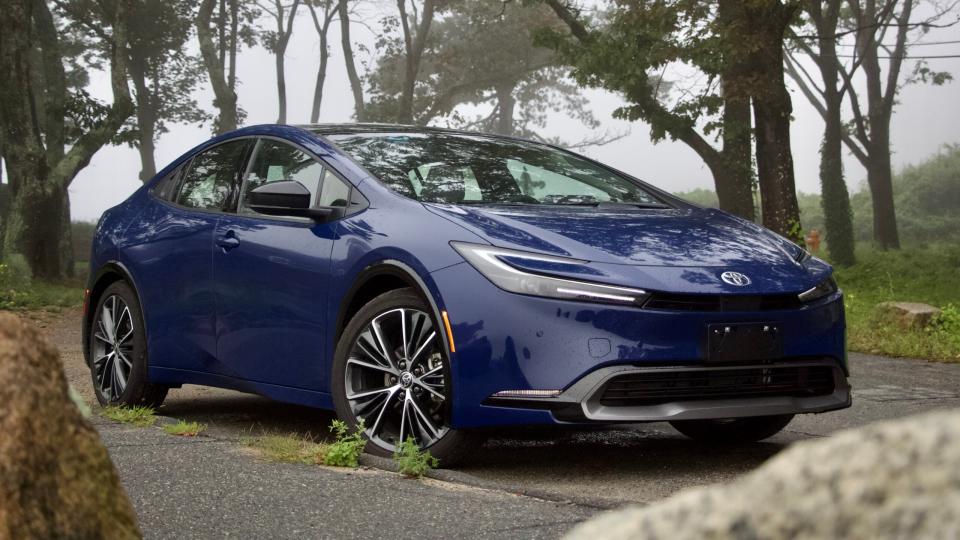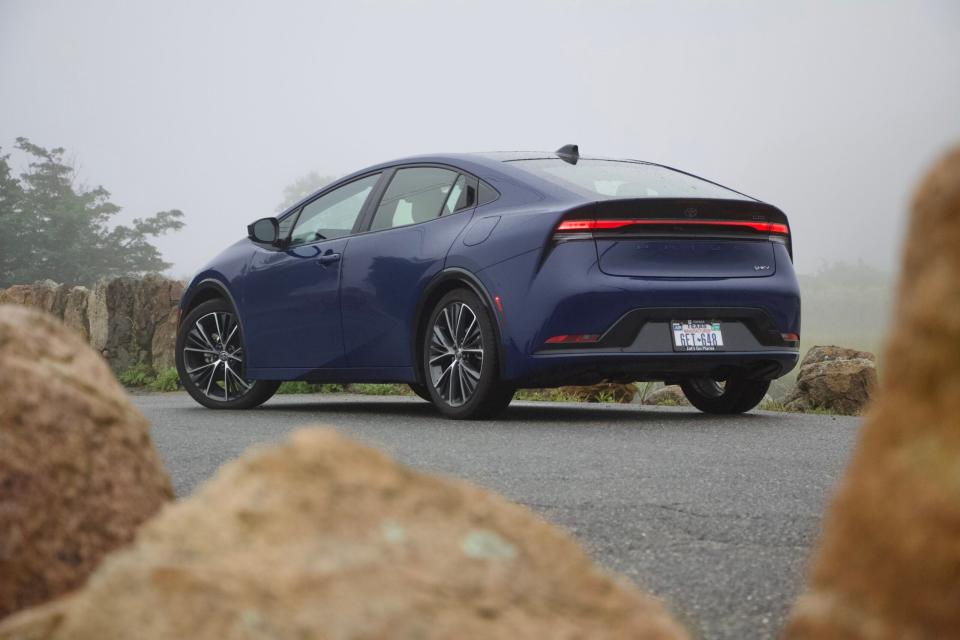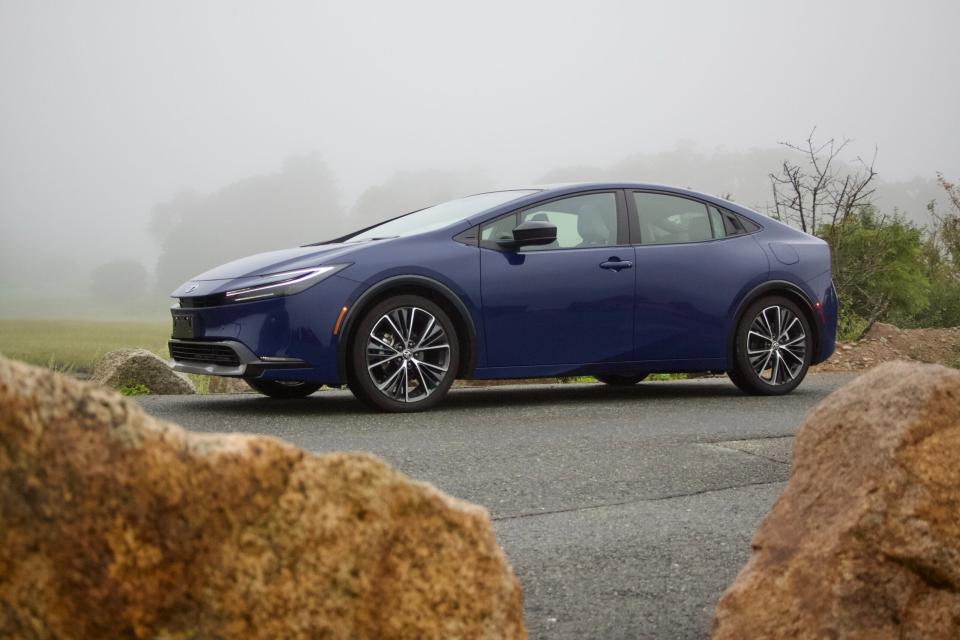2023 Toyota Prius Review: The Hero Hybrid We Need Right Now

You’ve seen the ads: “2023 Toyota Prius. It’s (insert mildly interesting adjective) now.” And, credit where credit’s due: the all-new, fifth-generation Prius is incredibly stylish. But here’s the thing: I’m not sure modern-day Prius buyers care very much about being chic. The early adopters have already bought EVs—or will soon—and the rest of us are sitting on the sidelines, waiting to see what happens next. That leaves hybrids as the choice for pragmatists who want to go further on a gallon of gas without changing their lifestyles. In the electrification landscape of 2023, the Prius is a compromiser’s car—and there’s nothing sexy about compromise, at least in theory.
The Prius’ value is, now more than ever, in its practical attributes, and those attributes had better be damn good. So, rather than focusing on its newfound curb appeal, I set out to answer the more important questions: Is it better at the things a Prius should be good at? Is it a more useful and frugal daily driver? And, yes, is it something a self-avowed car enthusiast wouldn’t mind living with? After driving a 2023 Prius Limited for a week and nearly 700 miles, I’ll spare you the suspense: it’s still the hybrid GOAT, and its unique mix of value, style, and competence means it’ll appeal to a broader swath of people than ever before.

2023 Toyota Prius Specs | |
|---|---|
The Basics
The 2023 Prius takes Toyota’s OG hybrid formula into its fifth generation, and in Toyota’s current lineup, it fits between the cheaper Corolla Hybrid and larger Camry Hybrid models. It wears entirely new sheetmetal over the existing TNGA-C platform that also underpins the Corolla and Corolla Cross, as well as the Lexus UX and the outgoing Prius. As a sedan in an SUV world, the Prius indirectly competes with its siblings, the Corolla Cross Hybrid and RAV4 Hybrid, but Toyota sought to differentiate it from those cars with a unique look.

OK, I said I wouldn’t talk about how this thing looks, but I lied. It’s stunning; somehow distinct from every other vehicle in the company’s lineup while also being recognizable as a Toyota. There isn’t a bad angle here, but I particularly like the way its lower door character crease and rear tail light extension lines create a sense of motion from the rear three-quarter view. The slope of the windshield is aggressive, and everything just works, especially in the Reservoir Blue of this tester. 19-inch alloys standard on the XLE and Limited models are sharp enough to draw compliments, but they come with an 8% fuel economy penalty—more on that later.
Inside, the Prius’ vibe is more conventional Toyota. The dash is centered around a 12.3-inch multimedia display with wireless Apple CarPlay, while the driver gets their own seven-inch digital cluster. Leather seats are pleasantly supportive and even reasonably bolstered, and there’s plenty of storage for smaller items in the center console and door pockets. The funky four-gate Prius shifter is back, although some effort has been made to dress it up in leather. Next to it is a six-by-two-inch slot that staff writer Peter Nelson called “the single best phone holder-slash-charging pad that's ever been conceived,” a title I’m inclined to agree with.





Rear legroom is spacious for two people, but three is a pinch. The sloping roofline—great for looks and aerodynamics—is less great for cargo room. A long weekend’s luggage for two fit just fine, but three suitcases was pushing it. The Prius’ duties under my care also included schlepping some of The Drive’s office junk around, and I found the low roof problematic there, too. In case you were wondering: an Aeron chair will fit in a Prius, but only if you load it through the rear door and not through the hatch. As much as it pains me to admit it, in our wagon-deprived world, I get why people who haul a lot of gear around buy SUVs.
The Prius is powered by a 2.0-liter naturally-aspirated four-cylinder engine and a permanent magnet AC synchronous electric motor, working together through a continuously variable transmission and Toyota’s patented Hybrid Synergy Drive. Its combined output of 194 horsepower is up 73 over the previous model while maintaining similar mpg figures—an impressive accomplishment.
Driving the Toyota Prius
“Competent” is the word I’d use to describe the new Prius’ performance and driving dynamics. Acceleration is adequate if not enthusiastic, steering is accurate, and you can now actually tell what the front wheels and chassis are doing in a corner. Its battery-fed torque won’t leave you flat-footed on a highway merge or red-light dash. Once you’re on the interstate, the ride is well-controlled, and Toyota’s standard assisted driving systems do a decent job of minding the road.

I did notice that the car’s Lane Tracing Assist ping-pongs against lane markings more than I’ve noticed with Hyundai’s system, for example. Radar-guided adaptive cruise control also refused to engage on a couple occasions, with no explanation given—but retrying minutes later solved the issue. These are minor nitpicks in an otherwise excellent highway cruiser and around-town commuter, especially one with a price tag in the low $30,000s. While I still wouldn’t call it exciting, driving a Prius is no longer a sacrifice.

 Yahoo Autos
Yahoo Autos 